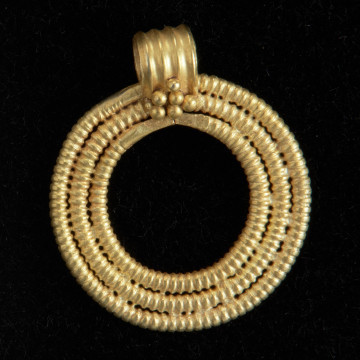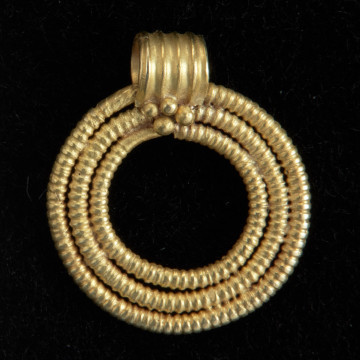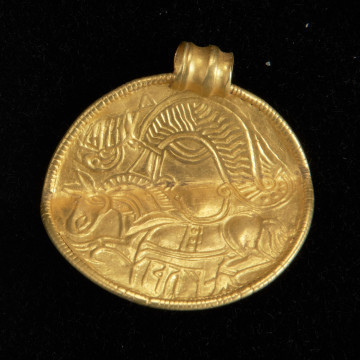
Ring pendant
National Museum in Szczecin
Part of the collection: Antiquity
The gold ring-shaped pendant is made of three concentric wire rings, two of which are covered with a dense, bead-like notched pattern. The inside of the pendant is filled with a beaded wire cross. The pendant has an eyelet made of the gold plate with ribs made in repoussé and chasing technique. On one side at the base of the eyelet there is an asymmetrical group of three flattened gold balls. Ring-shaped pendants of the presented type, with an inner cross, occur mainly in the southern Scandinavia, where they are dated to the 5th and 6th centuries. The specimen from Suchań was probably made in the middle of the 5th century. The best-known examples of such pendants come from the rich hoard of silver objects discovered at Sorte Muld II, a large settlement complex in north-eastern Bornholm which had a function of a power and worship centre, with supra-regional influence. Among over 30,000 artefacts found on this site, there were rich deposits of coins and ornaments, probably votive offerings. One of them contained bracteates and ring-shaped pendants analogous to those from the Suchań hoard. This proves the influence of the above-mentioned Bornholm centre on the rituals of the inhabitants of Western Pomerania or could be evidence of the presence of Scandinavian population groups in the region. Other analogies, located further away, include the Anglo-Saxon areas from the Merovingian period, e.g., Kent. The pendant was a part of a scattered hoard of gold objects discovered in Suchań in 2006 and 2007.
Bartłomiej Rogalski
Author / creator
Dimensions
cały obiekt:
Object type
pendicle, pendant
Technique
forming; punching
Material
gold
Creation / finding place
Owner
Muzeum Narodowe w Szczecinie
Identification number
Location / status

National Museum in Szczecin

National Museum in Szczecin

National Museum in Szczecin
DISCOVER this TOPIC
Museum of King Jan III's Palace at Wilanów
DISCOVER this PATH
Educational path